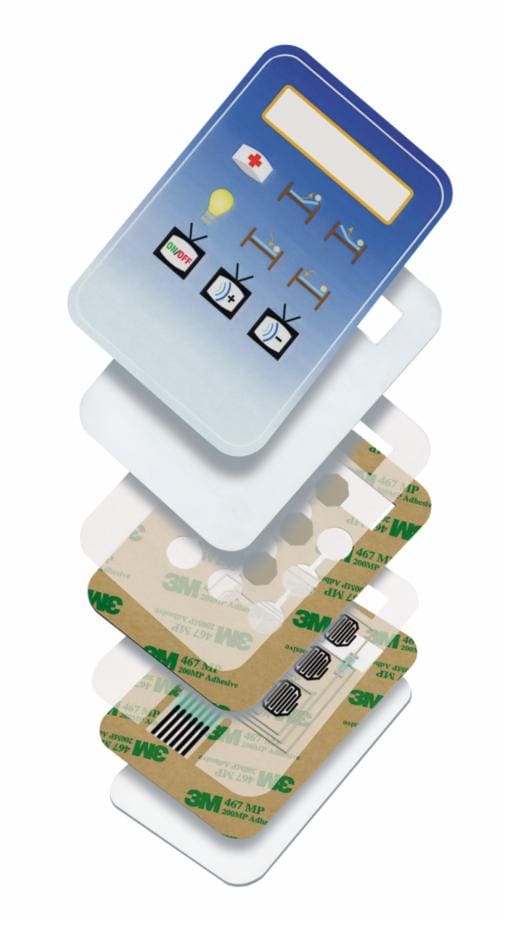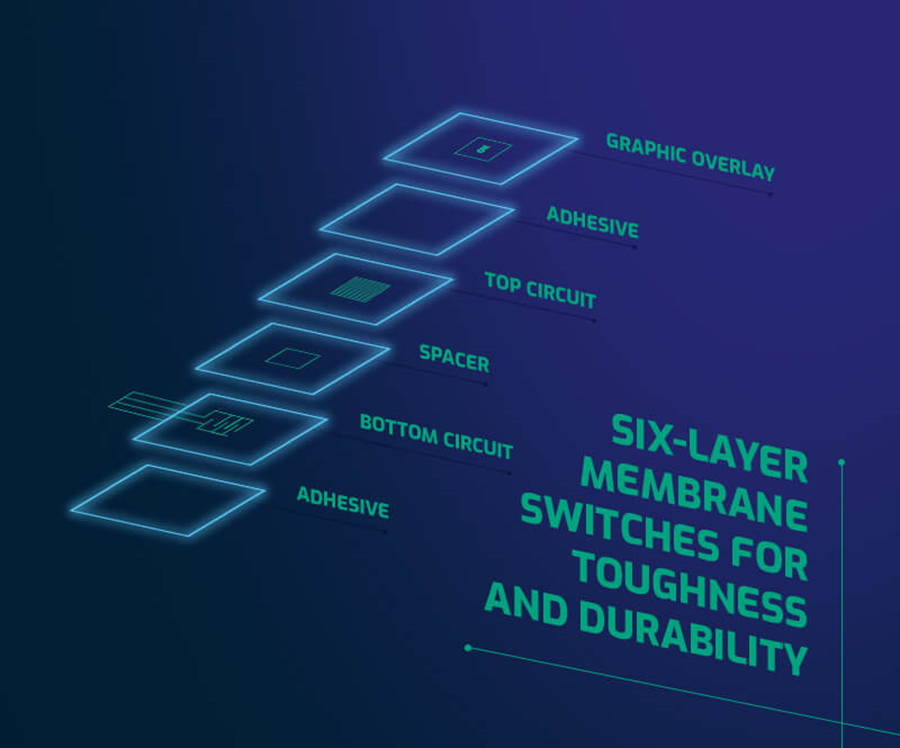The Production Refine Behind Membrane Layer Switch Over: What You Need to Know
The production procedure behind membrane changes combines careful style, product option, and high quality control. It starts with recognizing the intricacies of membrane layer button design and proceeds via different stages, consisting of product options and printing strategies. Each phase plays an important duty in making certain performance and durability. Nevertheless, the complexities of layer building and the strenuous testing criteria may expose understandings that are not right away noticeable. What lies past these foundational components?
Understanding Membrane Change Layout
Membrane layer buttons might show up simple at first glimpse, their style includes elaborate factors to consider that ensure capability and resilience. The style process starts with a comprehensive understanding of individual demands, consisting of the user interface's designated application and ecological aspects. Comfort designs is an essential aspect, as the design needs to assist in convenience of usage while making sure that responsive comments satisfies customer expectations.Moreover, the layering of elements, such as visuals overlays, sticky layers, and conductive traces, should be precisely engineered. membrane switch. This split arrangement not only influences the switch's responsiveness but also impacts its long life. Focus is provided to the sealing techniques used to safeguard versus wetness and dust, which can endanger efficiency. In addition, style factors to consider expand to visual appeals, where color design and visual clarity boost individual experience. Eventually, the design of membrane layer changes balances capability, customer experience, and durability, making certain that they satisfy the demands of numerous applications successfully
Materials Made Use Of in Membrane Switch Over Manufacturing
When picking materials for membrane layer switch production, it is important to consider both performance and longevity. The main materials consist of polyester and polycarbonate films, which supply flexibility and toughness. These films are typically covered with sticky to assure appropriate bonding to substratums. Conductive inks, usually made up of silver or carbon, are vital for producing electric connections within the button, permitting trusted operation.Additionally, a protective layer, such as a tough coat, is often applied to improve scrape resistance and longevity. The selection of backing product, such as acrylic or foam, can significantly influence the switch's tactile feel and overall user experience. Numerous ecological elements, consisting of temperature level and moisture, should direct product option to guarantee peak performance in particular applications. Inevitably, the appropriate combination of materials adds to the membrane layer button's capability and lifespan, making informed choices vital for suppliers.
The Printing Refine: Creating Video and Text
The printing procedure in membrane button production plays a significant role in producing premium graphics and message. Different visuals layout strategies are used to assure aesthetic allure and capability, while careful ink choice methods are vital for toughness and efficiency. Comprehending these components is basic for attaining ideal outcomes in membrane layer switch design.
Graphic Design Techniques
Graphic design strategies play a crucial function in the printing process of membrane layer buttons, as they define just how graphics and message will eventually appear on the last product. Effective visuals design entails the tactical use of fonts, formats, and colors to enhance readability and aesthetic appeal. Designers frequently make use of vector graphics for scalability, making sure that images stay sharp at various sizes. Additionally, interest to comparison and alignment is essential, as it affects individual interaction and visual top quality. The incorporation of branding aspects, such as logo designs, must be handled with like maintain brand name honesty. In general, thoughtful visuals layout methods add considerably to the performance and good looks of membrane buttons, impacting individual experience and item efficiency.
Ink Selection Techniques
Picking the appropriate ink is necessary for accomplishing the wanted aesthetic quality and toughness in membrane layer switch production. Different ink kinds are made use of, consisting of solvent-based, water-based, and UV-curable inks. Each type provides unique features, such as resistance, adaptability, and attachment to ecological variables. Solvent-based inks are frequently favored for their longevity and vibrant colors, while water-based inks are much more ecologically friendly but may have limitations in adhesion. UV-curable inks provide rapid treating and robust performance. Additionally, shade matching methods assure that the picked inks straighten with layout requirements. Inevitably, the selection of ink need to think about aspects such as application technique, substrate compatibility, and end-use demands to accomplish exceptional lead to membrane layer button graphics and text.
Layer Building and Assembly
Material Selection Process
A cautious choice of materials is important in the production procedure of membrane layer buttons, as it straight affects capability and resilience. The main products used include polyester, polycarbonate, and various conductive inks. Polyester is typically preferred for its exceptional resistance to chemicals and abrasion, making it ideal for rough settings. Polycarbonate, on the various other hand, gives premium clarity and impact resistance, which is advantageous for applications requiring visibility and robustness. Conductive inks, generally composed of silver or carbon, are vital for creating reliable electrical paths. In addition, the selection of glue materials influences the total stability of the button - membrane switch. Evaluating factors such as environmental direct exposure, responsive comments, and aesthetic needs overviews makers in choosing the very best materials for their specific applications
Layer Attachment Strategies
Adhering layers in membrane button building is an important process that assures capability and long life. Various attachment methods are employed to safeguard excellent bonding in between layers, which commonly consist of the usage of adhesives, warm, and pressure. Pressure-sensitive adhesives (PSAs) are generally used for their ease of application and prompt bonding abilities. Additionally, thermal bonding strategies can be applied, where heat is made use of to activate glue buildings, protecting a solid bond. The option of attachment method largely relies on the products included and the details application demands of the membrane layer switch. Correct positioning and uniform application of adhesives are crucial to avoid issues, securing the button runs efficiently throughout its desired lifespan.
Quality Assurance Measures
Ensuring top quality control during the layer building and setting up of membrane switches is necessary for maintaining performance and dependability. This procedure generally includes numerous crucial procedures, consisting of thorough evaluations at each phase of manufacturing. Suppliers utilize sophisticated screening approaches, such as peel tests and adhesion evaluations, to confirm the stability of layer bonds. In addition, aesthetic inspections are conducted to identify any type of flaws in printing or product incongruities. Ecological problems, such as temperature level and moisture, are carefully monitored to guarantee perfect treating and bond. Additionally, routine calibration of devices assists preserve accurate manufacturing standards. By implementing these top quality control measures, producers can considerably lower the threat of item failing, ensuring that the final membrane layer switches over satisfy the needed specifications and customer expectations.
Testing and Quality Assurance Actions

Developments in Membrane Switch Over Innovation
As developments in technology proceed to progress, membrane buttons are taking advantage of innovative developments that improve their capability Read Full Article and customer experience. One significant development is the integration of capacitive touch modern technology, which enables for more user-friendly and receptive interface. This change not only boosts appearances however also minimizes mechanical wear and tear, expanding the lifespan of the switches.Additionally, innovations in graphic overlay products have caused improved longevity and resistance to environmental variables such as moisture and UV light. These products currently provide enhanced clarity and brightness, more elevating the aesthetic appeal.Furthermore, the incorporation of wise modern technology is transforming membrane switches over into interactive control panels, allowing connection with IoT devices. This connectivity cultivates a smooth user experience, leading the way for applications in various markets, from medical care to customer electronics. Collectively, these technologies position membrane changes as critical components in contemporary gadget layout.
Regularly Asked Questions
The length of time Does the Membrane Layer Change Production Refine Take?
The period of the membrane layer button manufacturing process can vary considerably. Aspects such as intricacy, products made use of, and manufacturing quantity impact timelines, with regular production varying from a couple of days to several weeks for completion.
What Are the Common Applications for Membrane Switches?
Membrane buttons are commonly utilized in various industries, including automotive controls, household appliances, medical devices, and customer electronic devices (membrane switch). Their versatility and durability make them perfect for applications requiring user-friendly interfaces and dependable performance in varied settings
Can Membrane Layer Changes Be Personalized for Particular Needs?

What Is the Life expectancy of a Regular Membrane Layer Switch?
The life expectancy of a common membrane switch varies, however normally, it varies from 1 to 5 million cycles. Variables such as use, environment, and material quality considerably affect longevity and total performance over time.

Are Membrane Layer Switches Over Eco Pleasant?
The ecological friendliness of membrane switches differs. Some products utilized may not be recyclable, while others can be environmentally friendly. The general impact depends on making techniques and products, demanding mindful consideration throughout choice and disposal. The manufacturing process behind membrane layer changes combines click for source careful design, material choice, and quality control. It starts with comprehending the complexities of membrane button style and progresses via different stages, consisting of material selections and useful content printing methods. When selecting products for membrane switch manufacturing, it is essential to ponder both performance and durability. A mindful selection of products is vital in the manufacturing procedure of membrane buttons, as it directly influences functionality and longevity. The option of attachment technique greatly depends on the materials entailed and the certain application needs of the membrane button.